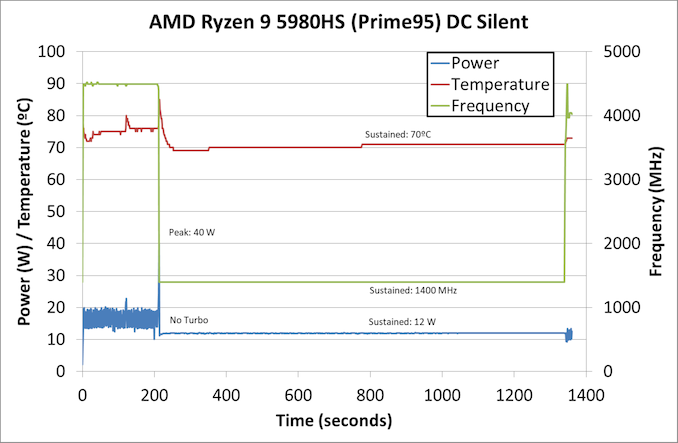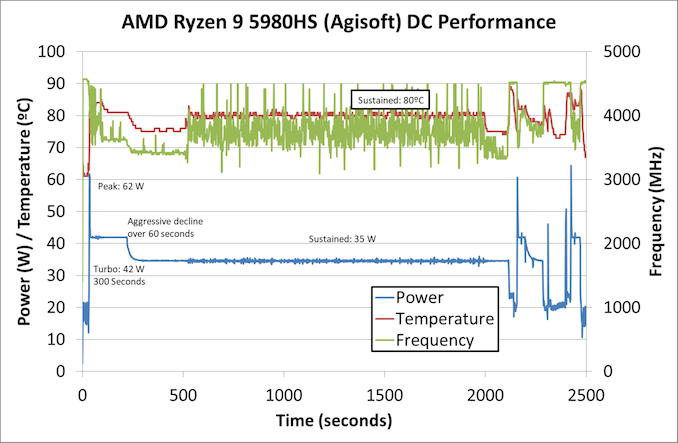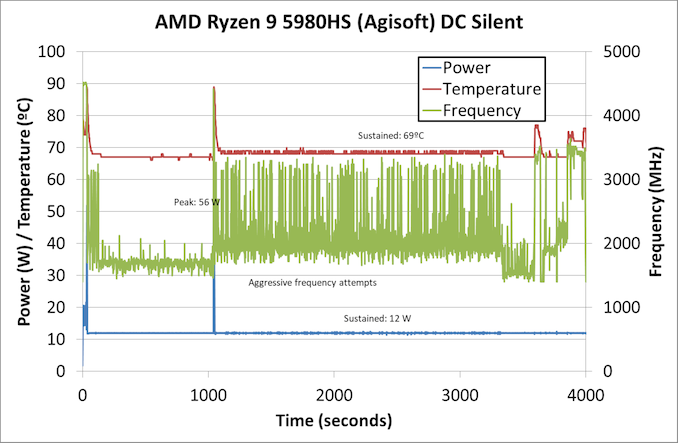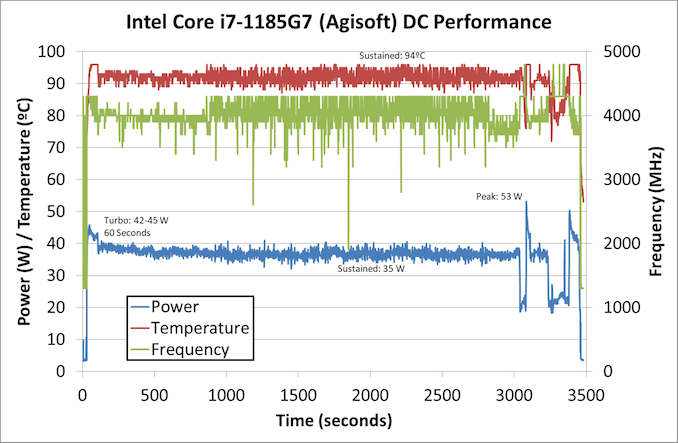AMD Ryzen 9 5980HS Cezanne Review: Ryzen 5000 Mobile Tested
by Dr. Ian Cutress on January 26, 2021 9:00 AM EST- Posted in
- CPUs
- AMD
- Vega
- Ryzen
- Zen 3
- Renoir
- Notebook
- Ryzen 9 5980HS
- Ryzen 5000 Mobile
- Cezanne
Power Consumption
The nature of reporting processor power consumption has become, in part, a dystopian nightmare. Historically the peak power consumption of a processor, as purchased, is given by its Thermal Design Power (TDP, or PL1). For many markets, such as embedded processors, that value of TDP still signifies the peak power consumption. For the processors we test at AnandTech, either desktop, notebook, or enterprise, this is not always the case.
Modern high performance processors implement a feature called Turbo. This allows, usually for a limited time, a processor to go beyond its rated frequency. Exactly how far the processor goes depends on a few factors, such as the Turbo Power Limit (PL2), whether the peak frequency is hard coded, the thermals, and the power delivery. Turbo can sometimes be very aggressive, allowing power values 2.5x above the rated TDP.
AMD and Intel have different definitions for TDP, but are broadly speaking applied the same. The difference comes to turbo modes, turbo limits, turbo budgets, and how the processors manage that power balance. These topics are 10000-12000 word articles in their own right, and we’ve got a few articles worth reading on the topic.
- Why Intel Processors Draw More Power Than Expected: TDP and Turbo Explained
- Talking TDP, Turbo and Overclocking: An Interview with Intel Fellow Guy Therien
- Reaching for Turbo: Aligning Perception with AMD’s Frequency Metrics
- Intel’s TDP Shenanigans Hurts Everyone
In simple terms, processor manufacturers only ever guarantee two values which are tied together - when all cores are running at base frequency, the processor should be running at or below the TDP rating. While manufacturers showcase a rating on the box, motherboard manufacturers often ignore it and use their own settings, based on the motherboard capabilities, making the CPU vendor ratings somewhat useless. The crucial thing is though, the CPU vendors actively encourage the motherboard vendors doing their own thing, creating confusion as to the real power consumption for the workload, and if the frequency on the box is actually what the user is going to get.
For laptops, it gets even worse than desktops. On a laptop, power consumption and frequency control are key parts of the design ethos, however we end up with nested-upon-nested options for power control. While the CPU vendor will have their own power control levels in firmware, the laptop vendor will have another set on top of this in the BIOS, and then the operating system will have another set on top of this, followed by another layer of laptop vendor software. Its turtles all the way down, and each variation produces something quite different.
AMD recommends that all the power levels be left where they are, and the user only controls the vendor software power options. In this case ASUS offers two modes: Silent and Performance. We mentioned these on the first page of this review, and showcased some odd numbers. It might be more striking if I just show the comparison.
To start, I’m simply going to showcase what a full sustained 10 minute CPU load does, first in Performance mode.
P95 is a heavy AVX workload for this processor, and in performance mode we see the processor peak at 56 W for a couple of seconds, and then hit its turbo mode at 42 W for 300 seconds. During this time we’re around 4000 MHz on all eight cores and sixteen threads, and the system cooling is keeping it around 80ºC. Once the 300 seconds has finished, the system slowly decreases to 35 W and 75ºC over the course of 60 seconds, before hitting a consistent 35 W. The frequency bounces as low as 3200 MHz, likely in line with the instructions from the test.
Now similarly, let’s go to the same benchmark in ‘Silent’ mode.
This looks a lot different. Here the system is prioritizing noise over anything else, and that also means reducing voltages and frequencies to the point of absurdity. There is no turbo to speak of in this workload, and the system comes down to 1400 MHz sustained at 70ºC and 12 W. This is still all eight cores, and the system is still quiet, but that is the tradeoff in these designs.
Moving to a more user-friendly workload, Agisoft, which is a mix of ST and MT.
At the start of the test we see the power peak at 62 W for a second or two, before coming down to a 300 second turbo of around 42 W. During this time the frequency comes down to around 3650 MHz, before reducing to 3400 MHz as the turbo budget runs out and the system drops to 35 W for a sustained mode. The second part of the test, which is multi-threaded, starts at around 500 seconds and showcases a sustained temperature of around 81ºC and an opportunistic frequency peaking at 4500 MHz, all while staying at 35 W. Towards the end of the test, as we start looking at single threaded workloads, the system peaks above 60 W on two occasions, but also shows 4500 MHz for ST activity. The CPU temperature rises more to 90ºC as the preferred core is used, but as it is only a single core the thermals are better managed and adjust accordingly.
The same workload in silent mode stays at 12 W for almost the entire test. We get a couple of peaks to 56 W, but the system tries to both stay quiet and stay around 68-69ºC by reducing frequency and power. The CPU still tries to remain opportunistic as we can see from the very spikey frequency graph in green, but it is in the region of 1700 MHz to 3300 MHz for most of the test. So while it takes 2443 seconds in performance mode, the same test takes 4059 seconds in silent mode.
This is probably showcasing the worst performance disparity between the two. In a lot of CPU tests, as you’ll see in this review, the differences can be minor. It showcases just how important it is to profile what workload you are running, and keep a close eye on what performance mode the system is running at (there isn’t a clear sign without actively checking the software).
Suffice to say however, in these tests, we do see a peak of 62-65 W on the Ryzen 9 5980HS. It is for all intents and purposes the briefest of spikes, and we don’t necessarily see any thermal increase to the extent that another 10 seconds of workload at 42-45 W does. The sustained turbo mode for 300 seconds is an impressive turbo mode that allows for higher frequencies in most workloads, with only the super sustained tests that might be more at home on a workstation or 15-to-17-inch notebook causing the processor to hit 35 W TDP. It also comes down to thermals, and given the design and temperatures we’re seeing, the ROG Flex 13 is very much a notebook, than a ‘laptop’. Users looking to actually use it on their lap would probably be best creating a thermal profile that keeps the temperature low at the expense of fan noise. When we examine the laptop in further detail, we’ll cover the issue of fan noise.
For completeness, here’s the Agisoft graph for the MSI Prestige 14 Evo in performance mode. Intel enables a turbo of 60 seconds, on which we see 42-45 W, although the peak observed is 53 W later in the test. We do see a sustained 35 W mode, averaging around 4000 MHz on all four cores. But what is perhaps worrying is the temperature, being reported as a sustained 92-94ºC on average. That’s quite high. Where the Ryzen 9 5980HS takes 2443 seconds to complete the benchmark, the Intel system takes 3389 seconds.















218 Comments
View All Comments
Zizy - Tuesday, January 26, 2021 - link
I wonder what is the point of new chips with old Zen2. 15% die size difference is meaningful but is that sufficient reason to bother (re)designing? As for the 5980HS, CPU part is pretty great when allowed to run at 35W. "Silent mode" is sometimes great but somewhat weird too - eg CB20MT shows a huge delta between the modes. Now lets just hope AMD/TSMC will manage to actually produce enough of these chips.ToTTenTranz - Tuesday, January 26, 2021 - link
"I wonder what is the point of new chips with old Zen2. "Diversified offer.
Fully operational Renoir is an arguably better performer than a flawed Cezanne with disabled units, and it's cheaper to make.
drothgery - Tuesday, January 26, 2021 - link
But how much cheaper? Zen 3's not that much of a bigger die than Zen 2, and it's fabbed on the same process.SaturnusDK - Wednesday, January 27, 2021 - link
How much cheaper? Until stocks last is my guess.Spunjji - Thursday, January 28, 2021 - link
I'd be interested in whether any of these differences in Lucienne are physical design alterations, as opposed to VRM / BIOS alterations, along with maybe some enabling of silicon that wasn't functional in Renoir for some reason.Either way, Lucienne's probably slightly more than 15% cheaper to make - not sure whether that would make up for the costs of extra masks and design work, though.
Farfolomew - Thursday, February 4, 2021 - link
Ian mentions in the article that he thinks AMD was stockpiling Renoir chips all of last year in order to make a big push with the 5000 series. Is it possible that the stockpiled chips are these Zen2 "Lucienne" variety and once they sell out of them, that's all there will be? I wonder if AMD is having TSMC manufacture new Lucienne chips. I mean, why would you make something that's inferior, if it's on the same exact node as a better product (Cezanne)?e36Jeff - Tuesday, January 26, 2021 - link
saving money. The Zen2 chips offer the power savings that Zen3 got with an already established design. That lets AMD sell them cheaper, and, lets face it, 95% of the end users out there would likely be blown away by a 5700U.On top of that, I would wager the Zen2 chips are a 100% straight drop in upgrade for any existing 4000 series mobile designs, possibly even with little to no BIOS update needed(beyond adding the CPU ID). That lets OEMs show off a Ryzen 5000 laptop with zero extra investment needed.
antonkochubey - Tuesday, January 26, 2021 - link
New chips with old Zen2 aren't really new chips, they're the same silicon and stepping, just running a newer firmware.jospoortvliet - Wednesday, January 27, 2021 - link
Read the review - there are lots of changes besides the cores that supposedly are also in the non-zen 3 5000 chips - given they also get the faster vega this seems true. I do agree it is weird..GeoffreyA - Wednesday, January 27, 2021 - link
From a personal point of view, I don't like this mixing of Zen 2 and 3, not at all, and certainly won't be glad of their continuing this practice; but it does make good sense. In a way, elegant.In this case, it helps to look at the cores as hidden, abstracted, a black box. Now, if such and such model fits its notch on the performance scale (5800U > 5700U > 5600U), then it shouldn't make much difference whether it's Zen 2 or 3 behind the doors. Sort of like an implementation detail.